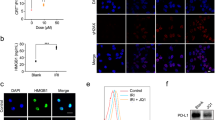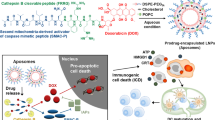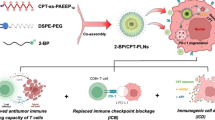Abstract
The blocking of the immune checkpoint pathway with antibodies, especially targeting to programmed death-1/programmed death ligand-1 (PD-1/PD-L1) pathway, was currently a widely used treatment strategy in clinical practice. However, the shortcomings of PD-L1 antibodies were constantly exposed with the deepening of its research and their therapeutic effect was limited by the translocation and redistribution of intracellular PD-L1. Herein, we proposed to improve immune checkpoint blockade therapy by using liposomes-coated CaO2 (CaO2@Lipo) nanoparticles to inhibit the de novo biosynthesis of PD-L1. CaO2@Lipo would produce oxygen and reduce hypoxia-inducible factor-1α (HIF-1α) level, which then downregulated the expression of PD-L1. Our in vitro and in vivo results have confirmed CaO2@Lipo promoted the degradation of HIF-1α and then downregulated the expression of PD-L1 in cancer cells for avoiding immune escape. Furthermore, to mimicking the clinical protocol of anti-PD-L1 antibodies + chemo-drugs, CaO2@Lipo was combined with doxorubicin (DOX) to investigate the tumor inhibition efficiency. We found CaO2@Lipo enhanced DOX-induced immunogenic cell death (ICD) effect, which then promoted the infiltration of T cells, strengthened the blocking effect, and thus provided an effective means to overcome the traditional immune checkpoint blockade treatment.

Similar content being viewed by others
References
Ribas, A.; Wolchok, J. D. Cancer immunotherapy using checkpoint blockade. Science 2018, 359, 1350–1355.
Sun, C.; Mezzadra, R.; Schumacher, T. N. Regulation and function of the PD-L1 checkpoint. Immunity 2018, 48, 434–452.
Han, X.; Shen, S. F.; Fan, Q.; Chen, G. J.; Archibong, E.; Dotti, G.; Liu, Z.; Gu, Z.; Wang, C. Red blood cell-derived nanoerythrosome for antigen delivery with enhanced cancer immunotherapy. Sci. Adv. 2019, 5, eaaw6870.
Dai, H. X.; Fan, Q.; Wang, C. Recent applications of immunomodulatory biomaterials for disease immunotherapy. Exploration, in press, https://doi.org/10.1002/EXP.20210157.
Smit, E. F.; de Langen, A. J. Pembrolizumab for all PD-L1-positive NSCLC. Lancet 2019, 393, 1776–1778.
Li, L. Y.; Miao, Q. W.; Meng, F. Q.; Li, B. Q.; Xue, T. Y.; Fang, T. L.; Zhang, Z. R.; Zhang, J. X.; Ye, X. Y.; Kang, Y. et al. Genetic engineering cellular vesicles expressing CD64 as checkpoint antibody carrier for cancer immunotherapy. Theranostics 2021, 11, 6033–6043.
Han, X.; Li, H. J.; Zhou, D. J.; Chen, Z. W.; Gu, Z. Local and targeted delivery of immune checkpoint blockade therapeutics. Acc. Chem. Res. 2020, 53, 2521–2533.
Voorwerk, L.; Slagter, M.; Horlings, H. M.; Sikorska, K.; van de Vijver, K. K.; de Maaker, M.; Nederlof, I.; Kluin, R. J. C.; Warren, S.; Ong, S. et al. Immune induction strategies in metastatic triple-negative breast cancer to enhance the sensitivity to PD-1 blockade: The TONIC trial. Nat. Med. 2019, 25, 920–928.
Ascierto, P. A.; Long, G. V.; Robert, C.; Brady, B.; Dutriaux, C.; Di Giacomo, A. M.; Mortier, L.; Hassel, J. C.; Rutkowski, P.; McNeil, C. et al. Survival outcomes in patients with previously untreated BRAF wild-type advanced melanoma treated with nivolumab therapy: Three-year follow-up of a randomized phase 3 trial. JAMA Oncol. 2019, 5, 187–194.
Yao, H.; Lan, J.; Li, C. S.; Shi, H. B.; Brosseau, J. P.; Wang, H. B.; Lu, H. J.; Fang, C. Y.; Zhang, Y.; Liang, L. X. et al. Inhibiting PD-L1 palmitoylation enhances T-cell immune responses against tumours. Nat. Biomed. Eng. 2019, 3, 306–317.
Burr, M. L.; Sparbier, C. E.; Chan, Y. C.; Williamson, J. C.; Woods, K.; Beavis, P. A.; Lam, E. Y. N.; Henderson, M. A.; Bell, C. C.; Stolzenburg, S. et al. CMTM6 maintains the expression of PD-L1 and regulates anti-tumour immunity. Nature 2017, 549, 101–105.
Han, X. Y.; Wang, L. L.; Li, T.; Zhang, J. H.; Zhang, D. L.; Li, J. L.; Xia, Y. H.; Liu, Y. L.; Tan, W. H. Beyond blocking: Engineering RNAi-mediated targeted immune checkpoint nanoblocker enables T-cell-independent cancer treatment. ACS Nano 2020, 14, 17524–17534.
Zhao, L.; Luo, Y. L.; Huang, Q. Y.; Cao, Z. Y.; Yang, X. Z. Photo-enhanced CRISPR/Cas9 system enables robust PD-L1 gene disruption in cancer cells and cancer stem-like cells for efficient cancer immunotherapy. Small 2020, 16, 2004879.
Tang, H. L.; Xu, X. J.; Chen, Y. X.; Xin, H. H.; Wan, T.; Li, B. W.; Pan, H. M.; Li, D.; Ping, Y. Reprogramming the tumor microenvironment through second-near-infrared-window photothermal genome editing of PD-L1 mediated by supramolecular gold nanorods for enhanced cancer immunotherapy. Adv. Mater. 2021, 33, 2006003.
Tu, K.; Deng, H.; Kong, L.; Wang, Y.; Yang, T.; Hu, Q.; Hu, M.; Yang, C. L.; Zhang, Z. P. Reshaping tumor immune microenvironment through acidity-responsive nanoparticles featured with CRISPR/Cas9-mediated programmed death-ligand 1 attenuation and chemotherapeutics-induced immunogenic cell death. ACS Appl. Mater. Interfaces 2020, 12, 16018–16030.
Xu, Z. K.; Wang, Q. N.; Zhong, H. P.; Jiang, Y. Y.; Shi, X. G.; Yuan, B.; Yu, N.; Zhang, S. B.; Yuan, X. Y.; Guo, S. T. et al. Carrier strategies boost the application of CRISPR/Cas system in gene therapy. Exploration 2022, 2, 20210081.
Manghwar, H.; Li, B.; Ding, X.; Hussain, A.; Lindsey, K.; Zhang, X. L.; Jin, S. X. CRISPR/Cas systems in genome editing: Methodologies and tools for sgRNA design, off-target evaluation, and strategies to mitigate off-target effects. Adv. Sci. 2020, 7, 1902312.
Verdera, H. C.; Kuranda, K.; Mingozzi, F. AAV vector immunogenicity in humans: A long journey to successful gene transfer. Mol. Ther. 2020, 28, 723–746.
Halligan, D. N.; Murphy, S. J. E.; Taylor, C. T. The hypoxia-inducible factor (HIF) couples immunity with metabolism. Semin. Immunol. 2016, 28, 469–477.
Noman, M. Z.; Desantis, G.; Janji, B.; Hasmim, M.; Karray, S.; Dessen, P.; Bronte, V.; Chouaib, S. PD-L1 is a novel direct target of HIF-1α, and its blockade under hypoxia enhanced MDSC-mediated T cell activation. J. Exp. Med. 2014, 211, 781–790.
Barsoum, I. B.; Smallwood, C. A.; Siemens, D. R.; Graham, C. H. A mechanism of hypoxia-mediated escape from adaptive immunity in cancer cells. Cancer Res. 2014, 74, 665–674.
Ding, X. C.; Wang, L. L.; Zhang, X. D.; Xu, J. L.; Li, P. F.; Liang, H.; Zhang, X. B.; Xie, L.; Zhou, Z. H.; Yang, J. et al. The relationship between expression of PD-L1 and HIF-1α in glioma cells under hypoxia. J. Hematol. Oncol. 2021, 14, 92.
Luo, J. C.; Shibuya, M. A variant of nuclear localization signal of bipartite-type is required for the nuclear translocation of hypoxia inducible factors (1α, 2α and 3α). Oncogene 2001, 20, 1435–1444.
Qian, X. K.; Zhang, Q.; Shao, N.; Shan, Z.; Cheang, T.; Zhang, Z. Q.; Su, Q.; Wang, S. M.; Lin, Y. Respiratory hyperoxia reverses immunosuppression by regulating myeloid-derived suppressor cells and PD-L1 expression in a triple-negative breast cancer mouse model. Am. J. Cancer Res. 2019, 9, 529–545.
Gao, S. T.; Jin, Y.; Ge, K.; Li, Z. H.; Liu, H. F.; Dai, X. Y.; Zhang, Y. H.; Chen, S. Z.; Liang, X. J.; Zhang, J. C. Self-supply of O2 and H2O2 by a nanocatalytic medicine to enhance combined chemo/chemodynamic therapy. Adv. Sci. 2019, 6, 1902137.
Jana, D.; Zhao, Y. L. Strategies for enhancing cancer chemodynamic therapy performance. Exploration 2022, 2, 20210238.
Lv, F. F.; Liu, H. F.; Zhao, G. Q.; Zhao, E. M.; Yan, H. Y.; Che, R. J.; Yang, X. J.; Zhou, X. H.; Zhang, J. C.; Liang, X. J. et al. Therapeutic exosomal vaccine for enhanced cancer immunotherapy by mediating tumor microenvironment. iScience 2022, 25, 103639.
Obeid, M.; Tesniere, A.; Ghiringhelli, F.; Fimia, G. M.; Apetoh, L.; Perfettini, J. L.; Castedo, M.; Mignot, G.; Panaretakis, T.; Casares, N. et al. Calreticulin exposure dictates the immunogenicity of cancer cell death. Nat. Med. 2007, 13, 54–61.
Xie, L. S.; Wang, G. H.; Sang, W.; Li, J.; Zhang, Z.; Li, W. X.; Yan, J.; Zhao, Q.; Dai, Y. L. Phenolic immunogenic cell death nanoinducer for sensitizing tumor to PD-1 checkpoint blockade immunotherapy. Biomaterials 2021, 269, 120638.
Ding, Y. Y.; Wang, Y. X.; Hu, Q. Y. Recent advances in overcoming barriers to cell-based delivery systems for cancer immunotherapy. Exploration 2022, 2, 20210106.
Liu, L. H.; Zhang, Y. H.; Qiu, W. X.; Zhang, L.; Gao, F.; Li, B.; Xu, L.; Fan, J. X.; Li, Z. H.; Zhang, X. Z. Dual-stage light amplified photodynamic therapy against hypoxic tumor based on an O2 self-sufficient nanoplatform. Small 2017, 13, 1701621.
Li, Z. W.; Rong, L. Cascade reaction-mediated efficient ferroptosis synergizes with immunomodulation for high-performance cancer therapy. Biomater. Sci. 2020, 8, 6272–6285.
Shen, S.; Mamat, M.; Zhang, S. C.; Cao, J.; Hood, Z. D.; Figueroa-Cosme, L.; Xia, Y. N. Synthesis of CaO2 nanocrystals and their spherical aggregates with uniform sizes for use as a biodegradable bacteriostatic agent. Small 2019, 15, 1902118.
Yu, Q.; Huang, T. C.; Liu, C.; Zhao, M. L.; Xie, M. J.; Li, G.; Liu, S. J.; Huang, W.; Zhao, Q. Oxygen self-sufficient NIR-activatable liposomes for tumor hypoxia regulation and photodynamic therapy. Chem. Sci. 2019, 10, 9091–9098.
He, C. C.; Zhang, X. J.; Yan, R. C.; Zhao, P. X.; Chen, Y.; Li, M. S.; Chen, C.; Fan, T.; Lu, Y.; Wang, C. et al. Enhancement of cisplatin efficacy by lipid-CaO2 nanocarrier-mediated comprehensive modulation of the tumor microenvironment. Biomater. Sci. 2019, 7, 4260–4272.
Xu, J. L.; Ma, Q. L.; Zhang, Y.; Fei, Z. Y.; Sun, Y. F.; Fan, Q.; Liu, B.; Bai, J. Y.; Yu, Y.; Chu, J. H. et al. Yeast-derived nanoparticles remodel the immunosuppressive microenvironment in tumor and tumor-draining lymph nodes to suppress tumor growth. Nat. Commun. 2022, 13, 110.
Fucikova, J.; Spisek, R.; Kroemer, G.; Galluzzi, L. Calreticulin and cancer. Cell Res. 2021, 31, 5–16.
Vultaggio-Poma, V.; Sarti, A. C.; Di Virgilio, F. Extracellular ATP: A feasible target for cancer therapy. Cells 2020, 9, 2496.
Teo Hansen Selnø, A.; Schlichtner, S.; Yasinska, I. M.; Sakhnevych, S. S.; Fiedler, W.; Wellbrock, J.; Berger, S. M.; Klenova, E.; Gibbs, B. F.; Fasler-Kan, E. et al. High mobility group box 1 (HMGB1) induces toll-like receptor 4-mediated production of the immunosuppressive protein galectin-9 in human cancer cells. Front. Immunol. 2021, 12, 675731.
Zheng, P.; Ding, B. B.; Jiang, Z. Y.; Xu, W. G.; Li, G.; Ding, J. X.; Chen, X. S. Ultrasound-augmented mitochondrial calcium ion overload by calcium nanomodulator to induce immunogenic cell death. Nano Lett. 2021, 21, 2088–2093.
Fan, M.; Liu, H. F.; Yan, H. Y.; Che, R. J.; Jin, Y.; Yang, X. J.; Zhou, X. H.; Yang, H.; Ge, K.; Liang, X. J. et al. A CAR T-inspiring platform based on antibody-engineered exosomes from antigen-feeding dendritic cells for precise solid tumor therapy. Biomaterials 2022, 282, 121424.
Acknowledgements
This work was supported by the National Natural Science Foundation of China (Nos. 31971304, 32271420, and 21977024), the Beijing-Tianjin-Hebei Basic Research Cooperation Project (No. 19JCZDJC64100), Cross-disciplinary Project of Hebei University (No. DXK201916), One Hundred Talent Project of Hebei Province (No. E2018100002), Science Fund for Creative Research Groups of Nature Science Foundation of Hebei Province (No. B2021201038), and Guangdong Basic and Applied Basic Research Foundation (No. 2021B1515120065). We are grateful to Medical Comprehensive Experimental Center of Hebei University for the animal experiment.
Author information
Authors and Affiliations
Corresponding authors
Electronic Supplementary Material
Rights and permissions
About this article
Cite this article
Che, R., Han, D., Wang, F. et al. Liposome-coated CaO2 nanoblockers for enhanced checkpoint blockade therapy by inhibiting PD-L1 de novo biosynthesis. Nano Res. 16, 7227–7236 (2023). https://doi.org/10.1007/s12274-022-5362-7
Received:
Revised:
Accepted:
Published:
Issue Date:
DOI: https://doi.org/10.1007/s12274-022-5362-7




